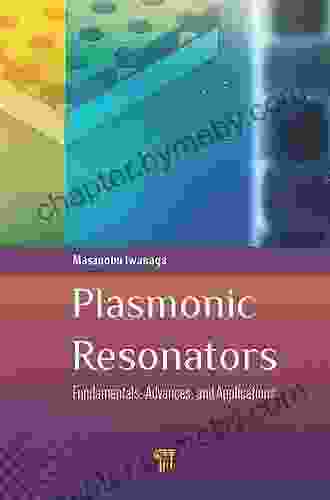Unlocking the World of Plasmonic Resonators: Fundamentals, Advances, and Applications

In the realm of optics, plasmonic resonators have emerged as groundbreaking devices that harness the unique properties of light and matter interactions. With their ability to confine and enhance electromagnetic fields, plasmonic resonators have opened up new possibilities in diverse applications ranging from sensing and imaging to telecommunications and energy conversion. In this comprehensive article, we delve into the fascinating world of plasmonic resonators, exploring their fundamentals, advancements, and cutting-edge applications.
Fundamentals of Plasmonic Resonators
Plasmonic resonators are nanometer-scale structures made of noble metals such as gold or silver. When light interacts with these structures, it excites surface plasmons, which are collective oscillations of free electrons on the metal surface. These surface plasmons can then resonate, creating highly localized and enhanced electric and magnetic fields.
5 out of 5
| Language | : | English |
| File size | : | 20290 KB |
| Text-to-Speech | : | Enabled |
| Screen Reader | : | Supported |
| Enhanced typesetting | : | Enabled |
| Print length | : | 325 pages |
The resonant behavior of plasmonic resonators is determined by several factors, including their shape, size, and material properties. By carefully tailoring these parameters, it is possible to achieve specific resonant wavelengths that can selectively interact with light of desired frequencies.
Types of Plasmonic Resonators
There are various types of plasmonic resonators, each with its unique characteristics and applications. Some common types include:
- Metallic Nanoparticles: Spherical or rod-shaped nanoparticles that exhibit strong plasmonic resonances in the visible and near-infrared regions.
- Nanoprisms and Nanoantennas: Triangular or star-shaped structures that provide directional emission and enhanced light-matter interactions.
- Metamaterials: Periodic arrangements of metallic structures that exhibit effective negative permittivity and permeability, leading to unusual optical properties.
- Photonic Crystals: Periodic structures that combine photonic bandgaps with plasmonic resonances, enabling the manipulation of light propagation and emission.
Advancements in Plasmonic Resonators
Research in plasmonics has witnessed significant advancements in recent years, leading to the development of novel plasmonic resonators with improved performance and functionalities. Some key advancements include:
- 3D Plasmonic Structures: Fabrication techniques have enabled the creation of three-dimensional plasmonic resonators with more complex geometries, offering enhanced control over optical properties.
- Hybrid Plasmonic Resonators: Integrating plasmonic structures with other materials, such as semiconductors or dielectrics, has led to hybrid resonators with tailored optical responses and functionalities.
- Chiral Plasmonic Resonators: Resonators with chiral geometry exhibit the ability to interact differently with left- and right-circularly polarized light, enabling applications in chiral sensing and metamaterials.
- Tunable Plasmonic Resonators: Resonators with tunable resonant wavelengths have been developed using materials such as liquid crystals or phase-change materials, allowing for dynamic control of optical properties.
Applications of Plasmonic Resonators
The unique properties of plasmonic resonators have led to a wide range of applications in various fields:
- Sensing: Plasmonic resonators can detect minute changes in refractive index, temperature, or chemical composition, enabling highly sensitive biosensors, gas sensors, and chemical detectors.
- Imaging: Plasmonic resonances can enhance the resolution and contrast in microscopy techniques, such as surface-enhanced Raman spectroscopy (SERS) and plasmonic fluorescence microscopy.
- Telecommunications: Plasmonic resonators can miniaturize optical components, such as filters, routers, and modulators, leading to compact and efficient photonic devices for optical communication.
- Energy Conversion: Plasmonic resonators can enhance light absorption in photovoltaic cells and photocatalytic devices, improving energy conversion efficiency.
Plasmonic resonators have revolutionized the field of optics, offering unprecedented control over light-matter interactions. Their unique properties have enabled groundbreaking applications in sensing, imaging, telecommunications, energy conversion, and beyond. As research continues to push the boundaries of plasmonics, we can anticipate even more transformative technologies and applications that leverage the extraordinary capabilities of plasmonic resonators.
For a comprehensive exploration of the fundamentals, advances, and applications of plasmonic resonators, delve into the groundbreaking book "Plasmonic Resonators Fundamentals Advances And Applications." This authoritative text provides a comprehensive understanding of plasmonics, empowering you to harness its transformative potential for groundbreaking innovations.
5 out of 5
| Language | : | English |
| File size | : | 20290 KB |
| Text-to-Speech | : | Enabled |
| Screen Reader | : | Supported |
| Enhanced typesetting | : | Enabled |
| Print length | : | 325 pages |
Do you want to contribute by writing guest posts on this blog?
Please contact us and send us a resume of previous articles that you have written.
 Book
Book Novel
Novel Page
Page Chapter
Chapter Text
Text Story
Story Genre
Genre Reader
Reader Library
Library Paperback
Paperback E-book
E-book Magazine
Magazine Newspaper
Newspaper Paragraph
Paragraph Sentence
Sentence Bookmark
Bookmark Shelf
Shelf Glossary
Glossary Bibliography
Bibliography Foreword
Foreword Preface
Preface Synopsis
Synopsis Annotation
Annotation Footnote
Footnote Manuscript
Manuscript Scroll
Scroll Codex
Codex Tome
Tome Bestseller
Bestseller Classics
Classics Library card
Library card Narrative
Narrative Biography
Biography Autobiography
Autobiography Memoir
Memoir Reference
Reference Encyclopedia
Encyclopedia Matt Zwolinski
Matt Zwolinski Meg Collins
Meg Collins Nick Mehta
Nick Mehta Richard Davies
Richard Davies Suzanne Wylde
Suzanne Wylde Signe Pike
Signe Pike Richard Louv
Richard Louv Sarah Zimmerman
Sarah Zimmerman Martin Odersky
Martin Odersky Philip Clayton
Philip Clayton Stalin Kay
Stalin Kay Steve Charney
Steve Charney Mary Emerick
Mary Emerick Michael Martin
Michael Martin Michael Streeter
Michael Streeter Sylvia Harris
Sylvia Harris Suzanne Love
Suzanne Love Michelle Rhee
Michelle Rhee Michelle Zimmerman
Michelle Zimmerman Nicola Morgan
Nicola Morgan
Light bulbAdvertise smarter! Our strategic ad space ensures maximum exposure. Reserve your spot today!
 Ismael HayesFollow ·11.9k
Ismael HayesFollow ·11.9k Cooper BellFollow ·11.1k
Cooper BellFollow ·11.1k Elmer PowellFollow ·6.6k
Elmer PowellFollow ·6.6k Carter HayesFollow ·7.4k
Carter HayesFollow ·7.4k Shannon SimmonsFollow ·14.2k
Shannon SimmonsFollow ·14.2k Darrell PowellFollow ·18.6k
Darrell PowellFollow ·18.6k Devin CoxFollow ·4.9k
Devin CoxFollow ·4.9k Ben HayesFollow ·17.5k
Ben HayesFollow ·17.5k

 Henry James
Henry JamesCold War Fighter Pilot Story: A Captivating Tale of...
Enter the Cockpit of...

 Rudyard Kipling
Rudyard KiplingYour Body Your Baby Your Choices: The Essential Guide to...
Pregnancy and...

 Fabian Mitchell
Fabian MitchellMichelle Obama: An Intimate Portrait - A Must-Read for...
Michelle Obama is a prominent figure in...

 Juan Butler
Juan ButlerUncover the Secrets of the Dead Land Warshawski Novels
Prepare to delve...
5 out of 5
| Language | : | English |
| File size | : | 20290 KB |
| Text-to-Speech | : | Enabled |
| Screen Reader | : | Supported |
| Enhanced typesetting | : | Enabled |
| Print length | : | 325 pages |















